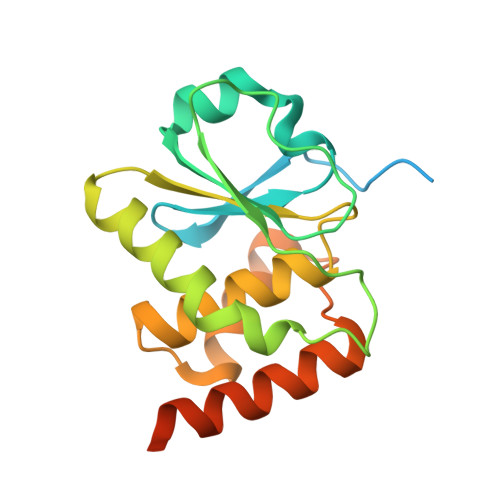Structural and biochemical analysis of atypically low dephosphorylating activity of human dual-specificity phosphatase 28
Ku, B., Hong, W., Keum, C.W., Kim, M., Ryu, H., Jeon, D., Shin, H.C., Kim, J.H., Kim, S.J., Ryu, S.E.(2017) PLoS One 12: e0187701-e0187701
- PubMed: 29121083
- DOI: https://doi.org/10.1371/journal.pone.0187701
- Primary Citation of Related Structures:
5Y15, 5Y16 - PubMed Abstract:
Dual-specificity phosphatases (DUSPs) constitute a subfamily of protein tyrosine phosphatases, and are intimately involved in the regulation of diverse parameters of cellular signaling and essential biological processes. DUSP28 is one of the DUSP subfamily members that is known to be implicated in the progression of hepatocellular and pancreatic cancers, and its biological functions and enzymatic characteristics are mostly unknown. Herein, we present the crystal structure of human DUSP28 determined to 2.1 Å resolution. DUSP28 adopts a typical DUSP fold, which is composed of a central β-sheet covered by α-helices on both sides and contains a well-ordered activation loop, as do other enzymatically active DUSP proteins. The catalytic pocket of DUSP28, however, appears hardly accessible to a substrate because of the presence of nonconserved bulky residues in the protein tyrosine phosphatase signature motif. Accordingly, DUSP28 showed an atypically low phosphatase activity in the biochemical assay, which was remarkably improved by mutations of two nonconserved residues in the activation loop. Overall, this work reports the structural and biochemical basis for understanding a putative oncological therapeutic target, DUSP28, and also provides a unique mechanism for the regulation of enzymatic activity in the DUSP subfamily proteins.
Organizational Affiliation:
Disease Target Structure Research Center, Korea Research Institute of Bioscience and Biotechnology, Daejeon, Republic of Korea.















